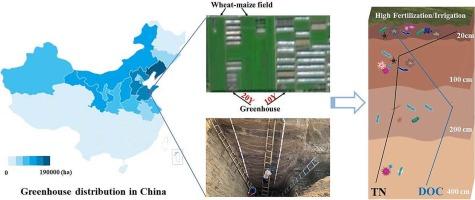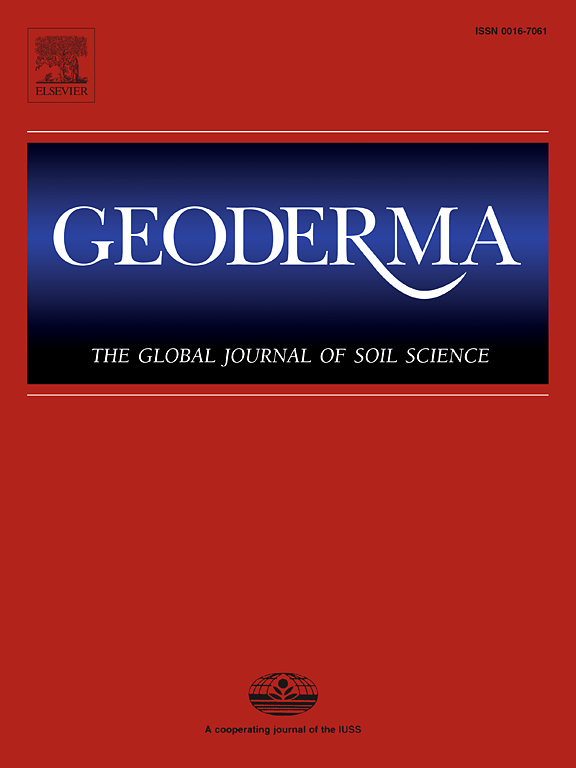深入挖掘长期温室栽培、过度施肥和灌溉对土壤细菌群落结构和组合的影响
IF 5.6
1区 农林科学
Q1 SOIL SCIENCE
引用次数: 0
摘要
温室栽培系统下的长期过量施肥和灌溉会造成氮素沥滤,而不同土壤深度的残留含量会随着栽培时间的延长而变化。然而,长期强化栽培是否会改变土壤细菌群落的组成和组合,尤其是深层(深达 4 米)的细菌群落的组成和组合,目前仍不清楚。本研究选取了寿光(典型的代表性集约化种植区)三个地点的土壤,即大棚单一栽培 20 年(G20)、大棚单一栽培 10 年(G10)和邻近的轮作田(F),进行了理化性质测定和高通量热序分析。结果表明,与土壤细菌群落组成的垂直特征相反,2 米土壤中主要是 Methylomirabilota,这是一种依赖硝酸盐/亚硝酸盐的厌氧甲烷氧化剂,是首次在土壤栖息地中发现。这要归功于高水平的溶解有机碳(DOC,201.2-255.7 mg kg-1),证明施用富含 C 的有机肥料(如植物残体)可有效防止温室土壤中累积的硝酸盐向下移动并威胁地下水。此外,温室栽培增加了细菌群落的层间组成差异,与丰富亚群落相比,稀有亚群落对环境变化的敏感性更高。总氮对细菌群落组成和组合的影响最大。因此,连续 20 年的单作显著降低了微生物共生网络的复杂性和物种扩散率,产生了低拟合的中性群落模型(NCM)和更专业化的生态位,尤其是稀有亚群落。就目前所知,这是第一项探索细菌群落组成可能发生的变化并量化稀有亚群落对该土壤深度长期温室栽培的反应的研究。Methylomirabilota 的发现拓宽了我们对深层土壤生态系统中微生物多样性的认识,并提示了其在土壤修复中的应用潜力。本文章由计算机程序翻译,如有差异,请以英文原文为准。

Digging deeper to find the effect of long-term greenhouse cultivation with excessive fertilization and irrigation on the structure and assemblage of soil bacterial community
Long-term excessive fertilization and irrigation under greenhouse cultivation systems cause nitrogen leaching, while the residual content varies at different soil depths with cultivation durations. However, it remains unclear whether it changes the composition and assemblage of the soil bacterial community, especially at deeper layers (as deep as 4 m), after long-term intensified cultivation. This study selected soils from three sites in Shouguang (a typical representative intensive planting area), i.e., greenhouse monoculturing for 20 years (G20), greenhouse monoculturing for 10 years (G10), and an adjacent rotation field (F) for physicochemical property determination and high-throughput pyrosequencing. The results showed that, contrary to the vertical characterization of soil bacterial community composition, the 2-m soil was dominated by Methylomirabilota, a nitrate/nitrite-dependent anaerobic methane oxidizer, uncovered for the first time in the soil habitat. This was attributed to the high levels of dissolved organic carbon (DOC, 201.2–255.7 mg kg−1), proving that applying C-rich organic fertilizers, e.g. plant residues, is effective in preventing accumulated nitrate from moving downward and threatening groundwater in greenhouse soils. Besides, greenhouse cultivation increased the inter-layer composition differences of the bacterial community, and compared with the abundant, the rare subcommunity showed higher sensitivity to environmental changes. The total nitrogen most significantly affected the bacterial community composition and assemblage. Therefore, 20 years of consecutive monocropping significantly decreased the microbial co-occurrence network complexity and species dispersal rate, yielding a low-fitted neutral community model (NCM) and more specialized ecological niches, especially for the rare subcommunity. As far as is known, this is the first study that explores the likely changes in the bacterial community composition and quantifies the responses of the rare subcommunity to long-term greenhouse cultivation at this soil depth. Discovery of Methylomirabilota broadens our understanding of micro-biodiversity in deep-soil ecosystem, and hints its application potential in soil remediation.
求助全文
通过发布文献求助,成功后即可免费获取论文全文。
去求助
来源期刊

Geoderma
农林科学-土壤科学
CiteScore
11.80
自引率
6.60%
发文量
597
审稿时长
58 days
期刊介绍:
Geoderma - the global journal of soil science - welcomes authors, readers and soil research from all parts of the world, encourages worldwide soil studies, and embraces all aspects of soil science and its associated pedagogy. The journal particularly welcomes interdisciplinary work focusing on dynamic soil processes and functions across space and time.
 求助内容:
求助内容: 应助结果提醒方式:
应助结果提醒方式:


